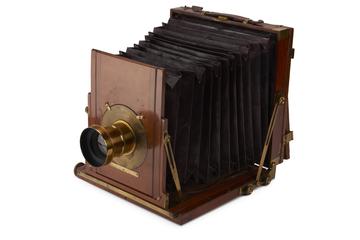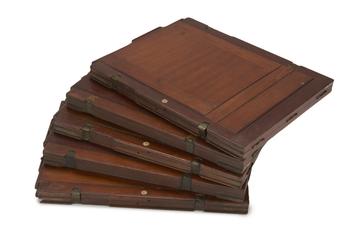
Samuel Dunseith McKellen 1836 - 1906
S. D. McKellen was born in 1836 in Northern Ireland. His family moved to Manchester the following year and Samuel trained as a jeweller and watchmaker. In around 1861, he opened a business on Brown Street and soon became a keen amateur photographer. By 1871, he had married Jane Jones and moved to 95, Market Street. However, Jane died of consumption and, in 1881, he married Eliza Moult, who came from a wealthy family. Samuel found the cameras available at the time to be cumbersome, awkward to use and generally inefficient. He soon designed a camera for his own use, which he called the Double Pinion Treble Patent camera. He also moved his business to 18, Brown Street.
Firstly, he equipped the baseboard with an integral turntable into which tripod legs fitted, in place of a loose tripod head. Secondly, the lens panel pivoted so that it could be clamped at any angle. The lens fitted through a hole in the baseboard, enabling the camera to be folded like a book. This made the camera more versatile to use and easier to pack up. Thirdly, a slotted strut system permitted tilting of both back and front panels. Two parallel rails in the baseboard allowed a racked frame to slide in and out for focusing. The lens panel was fixed to the sliding frame by struts. Milled-head screws permitted easy use of these movements while the photographer was focusing with his/her head under a dark cloth.
McKellen made his prototype and took it to Joshua Billcliff for manufacturing. Billcliff later remarked about it: ‘Ingenious, but it will fall to pieces in no time!’ He showed it to other members of the Manchester Amateur Photographic Society who were astounded by it. The Photographic Society of Great Britain awarded McKellen their first Prize Medal for photographic apparatus. The President was so impressed by the camera that he called it ‘the camera of the future’. Frederick Sanderson improved on the design to allow even more swing, and vertical and horizontal movement of the lens panel. His Universal Swing Front Camera, based on McKellen’s design, became a firm favourite with both amateur and professional photographers until the 1940s.
Following the Society’s award and recognition from the industry, McKellen set up a camera manufacturing business in Manchester. He had works on Chapman Street in Hulme and employed 35 people. His camera designs were picked up by other manufacturers and he brought suits for patent infringement against two major competitors, Billcliff and Thornton-Pickard.
In 1889, McKellen went on to introduce the first single lens reflex camera with automatic mirror, his Detective camera. This meant that the photographer could see the subject almost at the moment of exposure. When the shutter was opened, the mirror swung away, clearing the light path to the plate. Later cameras included the Infallible box-form magazine camera, which could carry a mixed load of glass plates and film sheets, and the Cathedral camera of 1898, which he advertised as ‘the smallest magazine camera extant’. McKellen had financial problems and mortgaged the rights to his triple patent camera, which made it difficult for him to prove his ownership of his ideas. His relationship with Eliza broke down and she moved the family away from him. By 1896, McKellen was working for Thompson & Co. at Bull’s Head Yard but, two years later, was running a business on his own account there. By 1899, he had set up a limited company at Mill Street, Long Millgate but again had financial trouble and the company was sold to RH Risk.
McKellen secured over 20 patents for improvements in cameras, including an ‘ever-ready’ case, a focuser and viewfinder, and a pocket folding viewfinder and view meter. He died in 1906 and his business was taken over by his son, J. D. McKellen, who carried on until around 1914. Samuel was buried in an unmarked grave in Marsland Cemetery in Sale.


